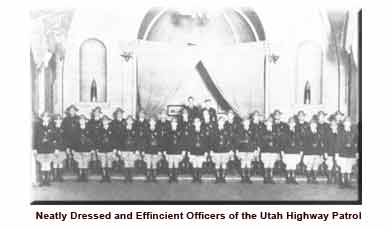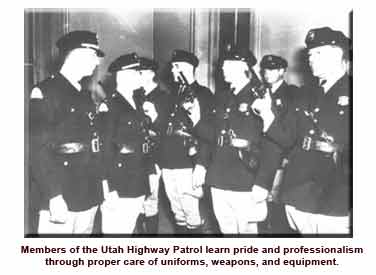Training
In June 1936, the United States Congress enacted the George-Deen Act, which provided federal funds for training in the public services. These funds were to be administered through the national and state Departments of Education. The states had to appropriate money to match federal funds. The state legislature of Utah in 1937 appropriated $100,000 to match federal money to carry out the program of education in the trades and industries and public service.
During October 10-14, 1938, a portion of this money was used to conduct a centralized training course, open to all peace officers in the state, at the University of Utah. There was no fee charged for this course. Daily attendance consisted of 96 officers. The classes were not the usual lecture course type, but were demonstrations, exhibitions, and general round-table discussions. Following this program, during the late fall of 1938, regional and zone schools were held in Logan, Ogden, Provo, Cedar City and Richfield. Instructors for these classes were officers who had either considerable experience, special training, or both. These classes covered three-day periods.
Those in charge of these programs soon realized that these experienced officers had little or no training or experience as teachers. In order to give these officers training in the art and technique of teaching, a three day “teacher-training course” was held at the University of Utah, March 9-11, 1939.
During the 1939 state legislative session, a bill was introduced that would establish a “Utah Police School” in connection with the University of Utah. This bill was sponsored by the Utah Peace Officers Association. The bill failed, and a bill to create a Utah Police Academy did not pass for 28 years – until 1967.
In September 1939, the Utah Highway Patrol coordinated a two week school open to all peace officers in Utah. Classes were held at Pinecrest Inn in Emigration Canyon. Sergeant Theodore Loveless, of the Indiana State Police, in coordination with the International Association of Chiefs of Police, was appointed as supervisor and instructor in charge of this training. Authorities from the Utah State Road Commission, the Utah Attorney General’s Office, the National Safety Council, the Utah State Tax Commission, the Deseret News, the University of Utah, the Salt Lake Telegram (now the Salt Lake Tribune), the United States District Attorney to Utah, the Utah Highway Patrol, the Salt Lake County Attorney’s Office, and a Salt Lake City judge were called upon as instructors for this historic school. This school became the forerunner of the Utah Highway Patrol Police Academy, established on July 6, 1959, at Camp Williams, Utah.
The first two classes were attended by 78 officers from the following departments: Utah Highway Patrol (50), Salt Lake City Police Department (17), Salt Lake County Sheriff Department (4), Public Service Commission (4), Ogden City Police Department (2), and Davis County Sheriff Department (1). In 1940, the Utah Peace Officers Association began similar training at the University of Utah.
Training and productivity were two words which were quickly becoming synonymous with being a Utah State Patrolman. 
A 1939 statistical report showed 5,275 arrests were made statewide with 133 arrests for drunk driving. The reason for such a low percentage of drunk driving arrests was four-fold; a weak drunk driving statute, lack of breath testing devices, lack of training, and no implied consent law. Due to an increase in traffic fatalities and patrolmen generating too few DUI arrests, a directive was distributed which ordered all patrolmen to “arrest for all offenses no matter how small and to accept no excuses of any type.” They were also instructed to “make arrests at every wreck whenever possible.”
By 1939, the National Safety Council had introduced breath testing devices to detect and prosecute drinking drivers. Although this technology was considered a major step forward in prosecuting drunk drivers, the definition of legal blood alcohol limits would not be drafted into law by Utah legislators for ten more years. (A presumptive level of .15 percent was not established by Utah law in 1949.) Also by 1939, seventeen Utah Highway Patrol patrol cars operating along the Wasatch Front were equipped with radio receiving units, tuned to KGPW, the Salt Lake City Police Department frequency. Additional issued equipment included a large tarpaulin, two woolen blankets, splints, tire chains, an axe, and a crowbar used for extrication of victims trapped in vehicles.
Superintendent Groo would often meet with state police and highway patrol superintendents from other states to discuss new techniques and new equipment in law enforcement. In 1939, Whitney Groo was elected Vice Chairman of the State and Provincial Section of the International Association of Chiefs of Police. Superintendent Groo also served as Vice President of the National Peace Officers Association. Despite his hard work and many involvements, Colonel Groo’s career in law enforcement was about to come to a swift conclusion.

